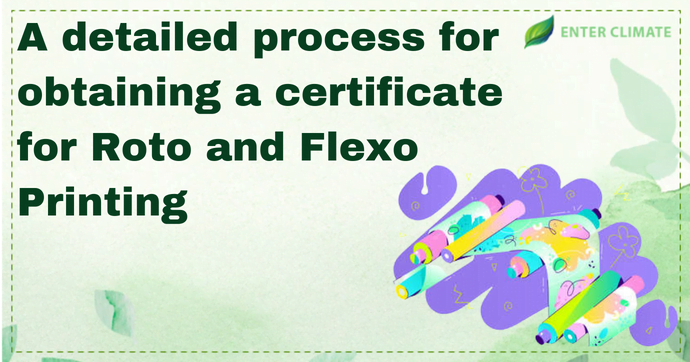A detailed process for obtaining a certificate for Roto and Flexo Printing
 15 Dec, 2022
15 Dec, 2022 
Roto printing and flexo printing are two of the most widely used printing technologies used in the printing market. Roto printing, also called rotogravure printing or gravure printing, is an intaglio printing process involving engraving an image onto an image carrier. Flexographic printing, on the other hand, uses a plate with a raised surface and fast-drying fluid inks to print directly onto the print material. Both printing methods use sleeves, cylinders and plates for printing and are capable of long-run and high-volume printing. A certificate for roto and flexo printing is required for the business to operate smoothly under the provisions of the Water Act and the Air Act[1]. While flexo printing has certain advantages over gravure printing in terms of cost of printing, the finish and feel associated with gravure printing give it an edge when printing quality is the primary concern for the user. But both gravure and flexo printing produces exceptional results and are equally popular in the segments of industries they cater to. Rotogravure printing inks an image onto your material through the use of metal plates. The surface of the metal plate has the impression of the desired image. This sunken area is then loaded with ink prior to making a printed impression on the substrate. Flexographic printing, in comparison, relies on raised flexible polymer plates to create images. Both printing technologies can be used to print for businesses requiring printing works for non-woven bags, paper bags, polythene printing etc. Continue reading the article to find out the detailed process for obtaining a certificate for roto and flexo printing and which type of printing business will be the best option for you. The basic requirements in both these printing process are
- Machine
- Labour
- Electricity
- Space
- Raw material
Factors to consider when deciding the type of printing business
Efficiency
A Flexographic printing press operates faster(at a speed of 350~500m/min) than a roto printer. Though a rotogravure press runs slower (averages at 120~200m/min.) but provides better registration accuracy (0.3mm~0.5mm)than flexo printers (0.05~0.08mm accuracy)
Energy Consumption
Air compressors are used to move the pneumatic cylinders in both printing machines. Apart from electricity consumption, the cost of running an air compressor is higher in the case of rotogravure printing. The electricity consumption in roto printing technology is also a bit higher.
Ink and solvent Cost
Both printing processes can use water or thinner as a solvent for paints. However, the solvent consumption is more in roto printing, which adds to the total cost of printing.
Demand of Printing
Flexo Printing: Flexo printing is extensively used for labels and packaging, is dependable and produces consistently high-quality print results. For all medium and long-run print applications, the flexo printing press is the most efficient and consistent printing machine available today. A flexographic printing machine allows printing on absorbent and non-absorbent surfaces and in multiple colours. Multi-colour flexo printing machines can print various colours on different materials with the help of the same machinery. Flexo Printing is in demand in the following industries.
- Food Packaging
- Corrugated Boxes
- Medical Packaging
- Newspaper and Others
Roto Printing: Although the operating costs are slightly higher in rotogravure compared to flexographic printing, roto printing tends to be more efficient in shorter runs as the cost of cylinder/ plates used is low. Also, rotogravure printing ensures reproducibility that is independent of the skillset of the operator. Rotogravure Printing is suitable for multi-colour continuous printing for roll materials and gives excellent printing performance on surfaces made of PET, BOPP, PVC, PE, aluminium foil and paper, etc. It comprises an unwinding unit, printing unit,in-feed drive unit, drying unit, out-feed drive unit, rewinding unit, control gauges and electrical control section. Unlike flexographic printing, roto printing is ideal for permanent design (higher quality) and limited creative reproductive possibilities.
Waste generated by Roto and flexo Printing units
Rotogravure printing and flexo printing are mainly water polluting, but the printing process also generates sludge that needs to be disposed of carefully. Moreover, the printing process also emits VOCs during printing and has been categorised as an orange category in the industry list maintained by CPCB. The ink sludge is a complicated mixture, which mainly contains aromatic hydrocarbon, chain hydrocarbon, benzene series, and other organic compounds. Many printing and packaging companies are installing VOC converters to reduce VOC emissions. If you care about the effect of your business on the environment, then an eco-friendly option, flexographic printing as rotogravure printing, uses solvent-based inks.
Certificate for Roto and Flexo Printing Unit Setup
Business Registration
DIC issues registration to MSMEs involved in Roto and flexo printing. Registering a printing business is necessary as it imparts a legal entity to the business.
Consent certificate for roto and flexo printing
A consent certificate for roto and flexo printing is required before the unit can start printing. Consent is issued in 2 stages, i.e. Consent to establish (CTE) and Consent to operate (CTO). The documents required for obtaining a certificate for roto and flexo printing are
- Online Application
- List of names, addresses and contact info of directors and partners
- Layout Plan
- Schematic diagram of the business operation
- Water consumption and Wastewater balance details
- land ownership Documents
- Project Report from CA
- Proof of payment of Consent fee
- Material safety data sheets
- List of plant & machinery installed by the unit.
- Monitoring reports for emission or trade effluents from SPCB recognised Laboratories.
Factory Licencecertificate for Roto and FlexoPrinting
Any establishment that falls within the definition of a factory must obtain a licence from their respective state labour department. The factory’s licence is meant to ensure safe working conditions for the workers. The documents required for this licence include
- Online Application
- requisite fees
- ID proof of Occupier and Manager.
- List of partners and directors with their contact details and addresses.
- NOC or Board Resolution for the nomination of the occupier.
- Proof/supporting documents from the Occupier as Director/ Partner of the factory.
- Latest electricity bill
- copy of rent agreement/ownership proof, i.e. conveyance deed
- Flow chart of the manufacturing process.
- List of raw materials used in the manufacturing process.
- List of machinery
- CTE/CTO issued by the Pollution Control Board of State
- Copy of Project Report
Additional Licences and certificate for Roto and FlexoPrinting Unit’s Setup
- Udyog Aadhar Registration
- Trader Licence/ certificate for roto and flexo printing
- Tie-up with TSDF operator
- Fire NOC
Conclusion
While the cost of printing machines depends on the number of colouring compartments in the machine, generally, a 4-compartment printing that can impart 4 different colours to a roll of material (paper, plastic, woven or non-woven fabric is enough for a small setup. However, these compartments can be expanded as the work gets complex. Also, the space required for the printing machines is relatively less, and both these businesses can be set up in small spaces and do not require intense labour as all the work is automated. However, the increasing scrutiny of Pollution Boards on printing units has made periodic renewal of the certificate for roto and flexo printing a mandatory requirement. A wise choice in this sector is to approach experts in licencing that can ease up the business setup and post compliances.













